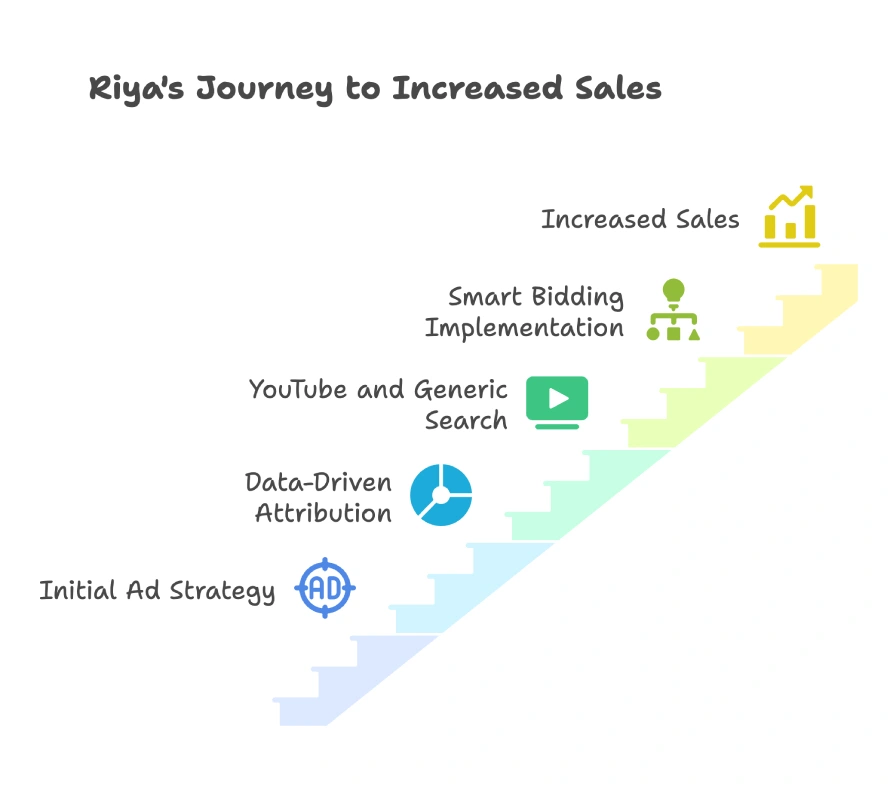The correct answer is “It leverages an account’s historical data to credit the most impactful ad touchpoints across Search, YouTube, and Display”. Why is this right, and why are the other choices wrong? In our Miteart blog, I will explain it in simple words so you can use it for study or your own blog.

Table of Contents
Question
How does data-driven attribution work?
A. It credits on an arbitrary basis and may impact optimizations, particularly when leveraging automated bidding data.
B. It prioritizes specific touchpoints and applies static logic to assign a constant value to a touchpoint along a conversion path.
C. It uses country or region specific data to credit several consistent ad touchpoints across the Search network specifically.
D. It leverages an account’s historical data to credit the most impactful ad touchpoints across Search, YouTube, and Display.
The correct answer
D. It leverages an account’s historical data to credit the most impactful ad touchpoints across Search, YouTube, and Display.
Details in voice:
Why the correct answer is right
Data-driven attribution uses machine learning on your account’s conversion history. It looks at many paths to conversion and learns which clicks and views most often lead to a purchase or lead. Then it gives more credit to the touchpoints that had the biggest impact and less to those that mattered less.
Because it works across Search, YouTube, and Display, it captures the whole journey from first discovery to final action. Using Smart Bidding with this model lets the system use better signals to set bids and budgets for higher-value moments.
Why the other options are wrong
A. Arbitrary credit that may hurt optimization
Data-driven attribution doesn’t guess. It uses real conversion paths from your account to learn which steps helped. It’s meant to improve optimization, not hurt it.
B. Static rules that give constant values
This describes rule-based models like first-click, linear, time-decay, or position-based. Data-driven attribution is dynamic and adjusts as your data changes.
C. Region data for Search only
Data-driven attribution isn’t limited to one region or to Search. It uses your account data and can credit touchpoints across Search, YouTube, and Display.
Real life example
Riya sells sports gear online. She uses Search, Shopping, and YouTube. On the last click, most credit goes to her brand search ads. After switching to data driven attribution, she sees that YouTube views and generic search clicks often start the journey. Smart Bidding now values those steps and shifts spend to the moments that move people forward. Sales rise while return on ad spend stays on target.

Comparison table
| Option | What it claims | Accurate | Reason |
|---|---|---|---|
| A | Credits on an arbitrary basis and may hurt optimization | No | Data driven attribution learns from your account and aims to improve results |
| B | Uses static rules to assign constant values | No | That is rules based attribution, not data driven attribution |
| C | Uses region data and Search only | No | Works across Search, YouTube, and Display with account data |
| D | Uses account history to credit the most impactful touchpoints across channels | Yes | Learns from real paths and assigns credit to the steps that matter most |
Relevant resource links
- About attribution models in Google Ads: https://support.google.com/google-ads/answer/7002714
- Attribution models GA4: https://support.google.com/analytics/answer/10596865
- Attribution Models in Google Ads: https://support.google.com/google-ads/answer/6259715
- About data driven attribution in Google Ads: https://support.google.com/google-ads/answer/6394265
Conclusion
Data driven attribution learns from your own results. It gives more credit to the interactions that actually influenced the customer and works across Search, YouTube, and Display. When paired with Smart Bidding, these better signals help the system find more value at the right time and place. It is not arbitrary, not static, and not limited to one network.
FAQs
What makes data-driven attribution different from last click?
Last click gives all credit to the final step. Data-driven attribution distributes credit across steps based on each step’s contribution.
Do I need a lot of data to use it?
Google has made this model widely available. More conversion data usually improves model quality, but you no longer need high thresholds to start.
Does it change my bidding?
Yes. When connected to Smart Bidding, the model gives stronger signals so bids can favor the most useful touchpoints.
How can I test it?
Use the Model Comparison report to compare Last Click and Data-Driven attribution. Track changes in conversions, cost per action, and return on ad spend over several weeks.
